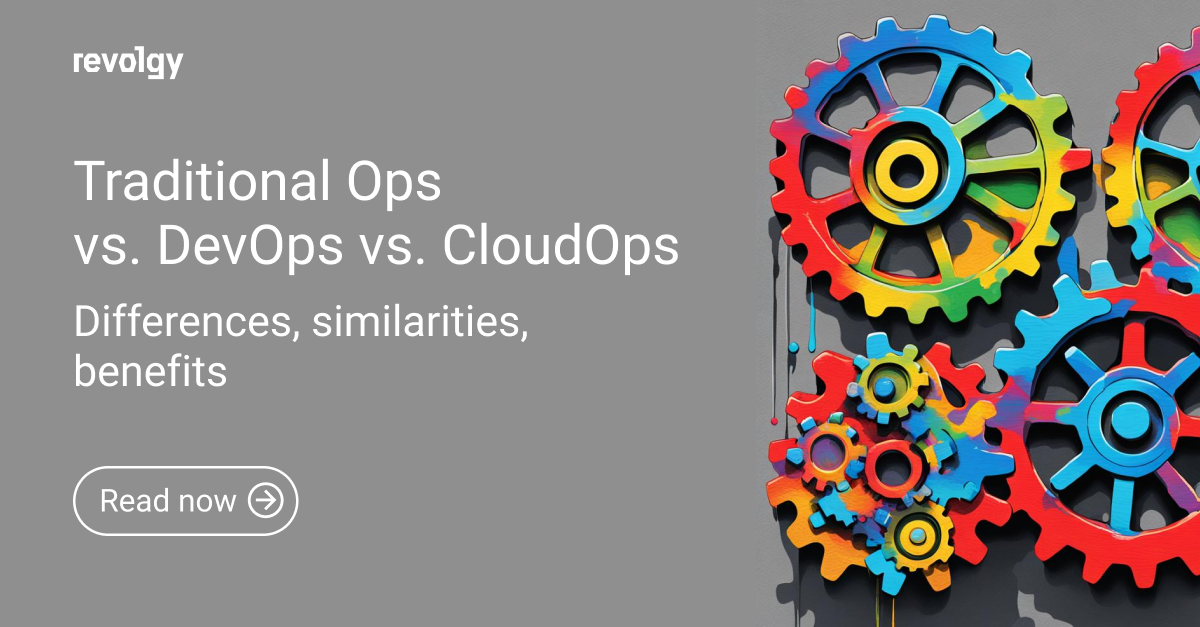AWS, GCP, Professional Services, Startups & Scale-ups
Cloud Native essentials for enhanced cloud infrastructure
Before the cloud, software applications were tied to the hardware servers they were running on. It seems like ancient times, but it is not too long ago.
In 2018, as Kubernetes and containers became the management standard for cloud vending organizations, the concept of cloud-native applications began to take hold. The shift towards cloud-native applications and architecture has become pivotal for businesses aiming to stay ahead.
Cloud-native approaches manage the power of the cloud for greater scalability, reliability, and flexibility, essential qualities today. At Revolgy, we specialize in navigating this complex terrain, offering bespoke solutions through industry leaders like AWS and Google Cloud.
What exactly are cloud-native applications?
- Built for the cloud: Designed from the ground up to leverage the cloud’s flexibility, they maximize the potential of on-demand resources to scale and adapt.
- Service-based architecture: They often use microservices architecture, where applications are broken down into smaller, manageable pieces that work together but are developed and deployed independently.
- Containers and orchestration: Utilizing containers, these applications encapsulate and run an application and its dependencies in resource-isolated processes. Orchestration tools like Kubernetes manage these containers effectively, handling scaling, fault tolerance, and deployment patterns.
At Revolgy, our approach transforms old-school software environments into agile, cloud-native ecosystems, ensuring businesses run and sprint ahead (see Revolgy Cloud Services).
Core principles of cloud native application development
When we talk about cloud-native, these principles are non-negotiable:
-
Microservices: Small, independent services make the system easier to manage and scale.
-
Immutable Infrastructure: Once deployed, components are replaced rather than changed to avoid inconsistencies.
-
Declarative APIs: Systems describe what they need without dictating how to do it
-
CI/CD: Continuous integration and continuous delivery automate the build, test, and deployment processes, enabling quicker, more reliable software updates without downtime, thereby accelerating service delivery and feature rollout.
- DevOps: DevOps merges development and operations teams into a single, agile entity focused on continuous improvement and automation, enhancing the speed and quality of cloud-native application development.
We at Revolgy bake these principles into our solutions, empowering seamless, scalable applications that meet and exceed our clients’ needs.
Cloud native tools and technologies
Here’s the toolkit every cloud-native enthusiast needs:
- Orchestration (e.g., Kubernetes): Manages container lifecycles for load balancing, scaling, and deployment. Think automation of deployments and scaling.
- Containerization (e.g., Docker): Wraps software in a complete filesystem containing everything needed to run. It is essential for creating containers that package an application with all its parts.
- Monitoring (e.g., Prometheus): This service monitors your applications and infrastructure to ensure they’re performing optimally, providing insights into performance and application health.
- Service Meshes (e.g., Istio): Handles service-to-service communications, which is crucial for microservices architectures.
By integrating these tools, Revolgy delivers solutions that streamline and turbocharge workflows. Learn more about these tools at Google Cloud Native Learning.
Benefits of cloud-native architecture and applications
Adopting a cloud-native architecture modernizes infrastructure and transforms how organizations deploy and manage their applications. It aligns development, operations, and security practices towards more efficient and agile processes. These improvements translate into a range of business and technological benefits:
- Faster delivery and reliable releases: Small, autonomous teams accelerate development cycles with the ability to build, test, and deploy rapidly in production-like environments, reducing deployment risks and enhancing delivery speed. CI/CD practices allow for frequent application updates without downtime, facilitating rapid iteration and innovation.
- Lower costs and simplified environments: Standardized, shared services and infrastructure significantly reduce the complexity and cost of testing and production environments.
- Enhanced security and higher availability: Vendors maintain core services like DBMS, ensuring up-to-date security patches and compliance, while cloud-native features such as autoscaling and auto-healing improve application reliability.
- Easier compliance: Implementing security controls at the platform level alongside a provider's adherence to frameworks like SOC2 simplifies compliance processes, reducing the burden on individual applications.
- Resilience: Built-in mechanisms such as health checks, retries, and failovers enhance the stability and availability of applications.
- Scalability: They scale automatically with demand, using resources only as needed, which optimizes costs.
Conclusion
Switching to a cloud-native architecture isn’t just upgrading your technology—it’s about revolutionizing your business's operations. With Revolgy’s expertise, your journey toward a sophisticated, cloud-native setup is in safe hands. Let’s make your systems as flexible and resilient as the cloud they run on.
Think it’s time your infrastructure caught up to the cloud age? Let’s talk. Together, we can build a cloud-native environment that’s ready for anything.

